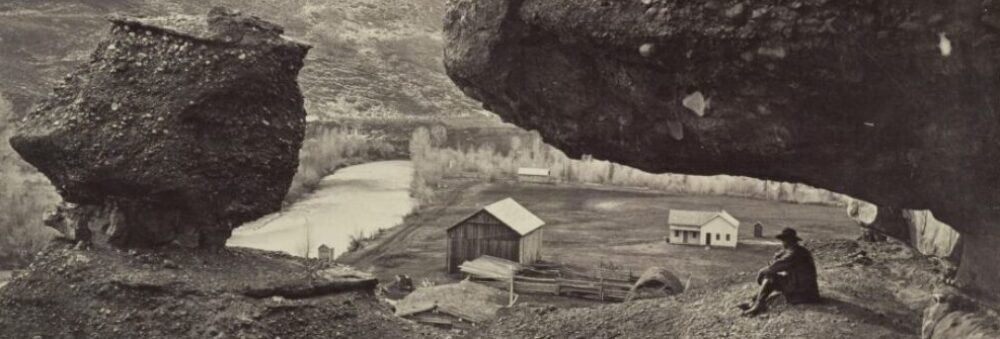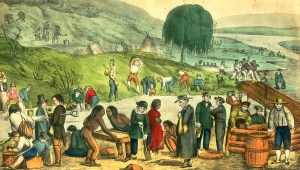
Daniel Gano Gold Rush Scrapbook,1846-1850. Online.
Several items from Princeton’s collections of Western Americana are currently on display in the Firestone Library Main Gallery exhibition, “A Republic in the Wilderness: Treasures of American History from Jamestown to Appomattox.” The exhibition begins with early English settlement, including contact with the native peoples, and then traces the growth of the American nation to the end of the Civil War. For more about the exhibition and related lectures and events, including an online exhibition, see the Manuscripts Division announcement, A Republic in the Wilderness.
The exhibition includes several works by leading figures of the American West, including artwork by George Catlin, William Henry Jackson photographs of Native Americans, a Brigham Young Letter and the first edition of the Book of Mormon (Palmyra, N.Y., 1830), and multiple manuscripts and other printed works highlighting the Westward expansion. Below are a handful of items currently on display with labels provided by the exhibition curators, Don Skemer, Curator of Manuscripts, and Anna Chen, Assistant Curator of Manuscripts.

Photographs of North American Indians, 1847–1865. Clockwise from upper left: Op-Po-Noos (photograph by Thomas M. Easterly, 1847); Cut Nose (photograph by Joel E. Whitney, ca. 1862); Unidentified Dakota Man (photograph by James McClees Studio, ca. 1858); Medicine Bottle (photograph by Joel E. Whitney, 1865); Bum-Be-Sun (photograph by Thomas M. Easterly, 1847); Ma-Za-Ka-Te-Mani (photograph by James McClees Studio, 1858). Western Americana Photographs Collection.
These photographs of Sac and Fox and Dakota Indians belong to one of two albums containing more than 1,000 mounted albumen prints, including portraits of delegates to Washington, D.C., expedition photographs, and early Western studio portraits. They were probably compiled by renowned photographer William Henry Jackson (1843–1942), who may also have written the numbers in the corner of each photograph.
The William Henry Jackson Albums are included as part of the nearly 7,000 Western Americana photographs digitized for the Princeton University Digital Library. To view the entire albums, see Photographs of North American Indians.

Carleton Watkins (1829–1916), Lake Ah-Wi-Yah, Yosemite Valley, California, 1861. Gift of Thomas Lange. Western Americana Photographs Collection.
After emigrating from his hometown of Oneonta, New York, in 1851, Carleton Watkins found work as a photographer’s aide in San Francisco. Once in business for himself, he began photographing the Yosemite Valley and California mining scenes. His stereoviews and mammoth photographs of Yosemite made him famous and helped to influence federal legislation to protect the valley, which President Abraham Lincoln (1809–1865) signed on June 30, 1864.
Lake Ah-Wi-Yah and seventy other photographs by Carleton Watkins are also available in the Princeton University Digital Library. See Carleton Watkins

Brigham Young (1801–1877), Letter to Harriet Cook Young, June 23, 1846. Gift of Edith Young Booth. Brigham Young Collection.
After Joseph Smith (1805–1844), the founder of the Mormon faith, was killed by a mob in 1844, Brigham Young took over the leadership of the Church of Jesus Christ of Latter-day Saints. To escape anti-Mormon persecution, he led a vanguard westward, reaching the Salt Lake Valley in July 1847. During the journey, he wrote this letter to his fourth wife, Harriet Cook Young (1824–1898), whom he had secretly married and left in Nauvoo, Illinois, urging her to come west. She arrived in Salt Lake City in September 1848.
In 2012, Princeton’s Brigham Young Collection was digitized for an undergraduate history course on the American West. See Brigham Young Collection.
To view these and other Western Americana highlights currently on display, visit the Main Gallery of the Firestone Library now through August 4, 2013. For hours and information, see Information for Visitors. The Firestone Library is located on the corner of Nassau Street and Washington Road (#5 on the campus map) and the address for GPS directions is One Washington Road, Princeton, NJ, 08544.



